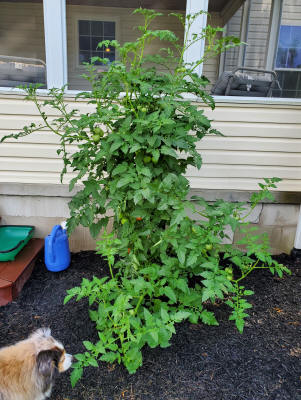Betty Jakum
Adams County Master Gardener
 Tomatoes are the most popular vegetable grown in American gardens. Numerous varieties provide so many choices, and gardeners, whether first-timers or experts, eagerly plant their favorites. The consensus is that tomatoes are relatively easy to grow and provide delicious, abundant harvests. Personally, I find them more of a mystery than that.
Tomatoes are the most popular vegetable grown in American gardens. Numerous varieties provide so many choices, and gardeners, whether first-timers or experts, eagerly plant their favorites. The consensus is that tomatoes are relatively easy to grow and provide delicious, abundant harvests. Personally, I find them more of a mystery than that.
For quite some time, I have been bothered by the fact that in some of my earlier amateur attempts at gardening I grew better tomatoes than I do now. There was never a shortage of tomatoes, and there were many summers dedicated to growing, canning and otherwise preparing them for the months ahead.
Over the ensuing years, I have tried other varieties before coming to grow almost exclusively heirloom varieties. Once I became aware of them, sometime in the early 1990s, I fell in love with their varieties, their delightful names and their interesting histories. My home, an old farmhouse built in the 1840s, seemed the perfect place to grow heirloom tomatoes. Who could resist tomatoes with names like Brandywine Red, Amish Paste, Cherokee Purple and German Johnson? My all-time favorite was a small oval tomato that grew in bunches like grapes that an old neighboring farmer claimed reseeded itself every year. The variety was called Riesentraube which predictably enough translated into ‘Giant Bunch of Grapes’ in German.
Unfortunately, along with the allure and variety of heirlooms came a whole new set of tomato-growing problems. In the past I had simply purchased bare-rooted tomato plants varieties unknown, put them in the ground, added some fertilizer and watered them in. They seemed to tend themselves until I harvested them. Now I was dealing with heirloom tomatoes that had more specialized requirements.
First of all, they needed more support. Most heirlooms are the Indeterminate type of tomato which means they have a vining characteristic and can grow 8 to 10 feet tall. As a result, the vines need careful staking to allow for continued fruiting and to keep the tomatoes off the ground.
Typical tomato cages wouldn’t do. Sturdier stakes made from wood, bamboo and sometimes even metal worked much better. Plants needed to be secured to the stakes so now an assortment of twist ties, clips and hooks were required to attach the plants to the stakes. In addition, the best way to have healthy, productive Indeterminate plants was to prune them, a complicated process involving advanced gardening skills that is too long a subject to address here.
Also, these types of tomatoes required a longer growing season, sometimes producing well into fall, which made them more susceptible to insects and diseases. They provided tomatoes throughout the growing season it is true, but the harvest was sparse and often riddled with disease.
All of which brings me back to my tomato-growing predicament. What was going on with my tomatoes? I obsessed over contaminated soil, rampant increases in fungal and viral diseases, not to mention dramatic growth in harmful insects, and devious marketing strategies by large seed conglomerates to weaken the quality of tomato seeds available to the general public.
Then I came across an article discussing Determinate and Indeterminant tomatoes. I skimmed it briefly because it was basic 101 information I had known for years. Yet there were words and phrases that made me pause and wonder about what I was reading. Like a lightbulb blinking on, it suddenly occurred to me that when the article talked about Determinate tomatoes it was giving a very accurate description of the tomatoes I grew years ago. Could it be that simple? Were my earlier varieties Determinate tomatoes? Looking at the growth habits of Determinate tomatoes certainly did suggest possibilities.
The main difference between the two categories of tomatoes is how they set fruit. Determinates have fruit that ripens earlier, almost all at once over a short period of time. The plant is bushier, stockier and genetically bred to stop growing usually somewhere around 3 to 4 feet tall. It produces the main crop of its tomatoes over a two-to-four-week period, making it the better choice for those interested in canning tomatoes. It is more productive than the Indeterminate variety. Indeterminates put energy into growing up; Determinates put energy into ripening fruit.
This more compact growth habit means the plants will grow quite successfully with little added support, thus eliminating staking. Side shoots do not need to be pruned either. After the main cropping, extra fruit is produced from side shoots that add to the overall harvest. Determinate tomatoes grow well in containers too. They are better behaved and not so gangly.
Finally, Determinates have better disease resistance. Often, they grow and yield their tomatoes before diseases and insects can get a stronghold. The gardener is looking at keeping them disease free for about 100 days compared to the four-month period those growing Indeterminates must deal with.
If you’re a gardener with a growing family to feed who is trying to manage an ever- expanding grocery bill by growing your own, maybe you should consider planting Determinate tomatoes. If a tomato plant or two will serve you well the entire summer, consider the Indeterminate ones.
This article is by no means meant to suggest that any tomato, whether Indeterminate or Determinate, is better than the other. It is just the story of one gardener looking at the obvious and having no idea what she is seeing. It is about the perpetual allure of gardening that there is always something new to learn, and sometimes to relearn what you have known all along.
Read other articles on growing herbs or vegetables